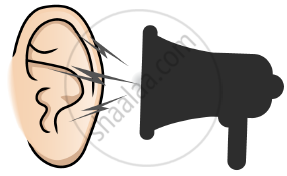Advertisements
Advertisements
प्रश्न
Given below is a representation of a kind of pollution. Study the same and answer the questions that follow

(i) Name the kind of pollution.
(ii) List any three common sources of this pollution.
(iii) Mention three harmful effects of this pollution on human health.
(iv) Explain the term ‘Pollutant’.
(v) Name two soil pollutants
उत्तर
(i) Noise pollution
(ii) Sources of noise pollution:
- Use of loudspeakers and musical bands in public places
- Sounds generated by industrial machines
- Landing and taking off of aeroplanes, jets and other aircraft
(iii) Harmful effects of noise pollution on human health:
- Loud sounds cause damage to the ear drum which can lead to deafness
- Lowered work efficiency
- Nervous irritability
(iv) Any substance which causes pollution is called a pollutant.
(v) Plastic and radioactive substances are soil pollutants.
APPEARS IN
संबंधित प्रश्न
A fluid that occupies the larger cavity of the eye ball behind the lens is
___________.
the biological/technical terms for a thin membrane covering the entire front part of the eye.
The exact location of the Yellow spot
Sclerotic layer or choroid layer.(Which one forms the Iris ?)
The three parts of human ear contributing in hearing are-
State whether the following statements are true (T) or false (F). If false, correct them by changing any one single word in each.
Deafness is caused due to rupturing of the pinna.
Mention if the following statement is true (T) or false (F) Give reason.
The auditory nerve is purely for perceiving sound
Where is the Semicircular canals located? Briefly mention its function.
Name the three ear ossicles.
Name the nerve which carries electrical impulses from the cochlea of ear to the brain.
Why should we not put a pin or pencil in our ears ?
The figure below is the sectional view of a part of the skull showing a sense organ:

Name the part labeled 'tm'. What is its function?
Differentiate between:
The middle ear and Inner ear.
Complete the following sentence with appropriate Word
The sequence of ear ossicles of vertebrates starting from the tympanum is:
Assertion: Human beings Cannot hear infrasonic sounds.
Reason: Sound with a frequency less than 20 Hz is called infrasonic sound.
The Eardrum moves inward when a rarefaction reaches it.
X is known as the balancing organ of ear.
Choose the correct option for X.
Give reason:
Three small bones of ear ossicles are advantageous as compared to one single bone for hearing.
- Draw a neat and well labelled diagram of the membranous labyrinth found in the inner ear.
- Based on the diagram drawn above in (i), give a suitable term for each of the following descriptions:
- The structure responsible for hearing.
- The sensory cells that help in hearing.
- The membrane-covered opening that connects the middle ear to inner ear.
- The nerves that carry impulses from the ear to the brain.
- The tube which equalises the air pressure on either side of the ear drum.
